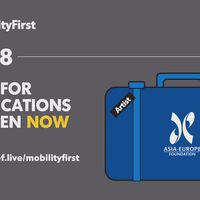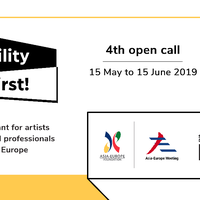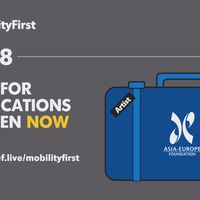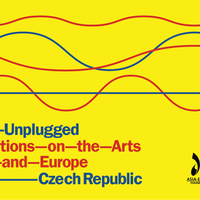Mobility First! 2019: What we learnt about cultural mobility in Asia and Europe
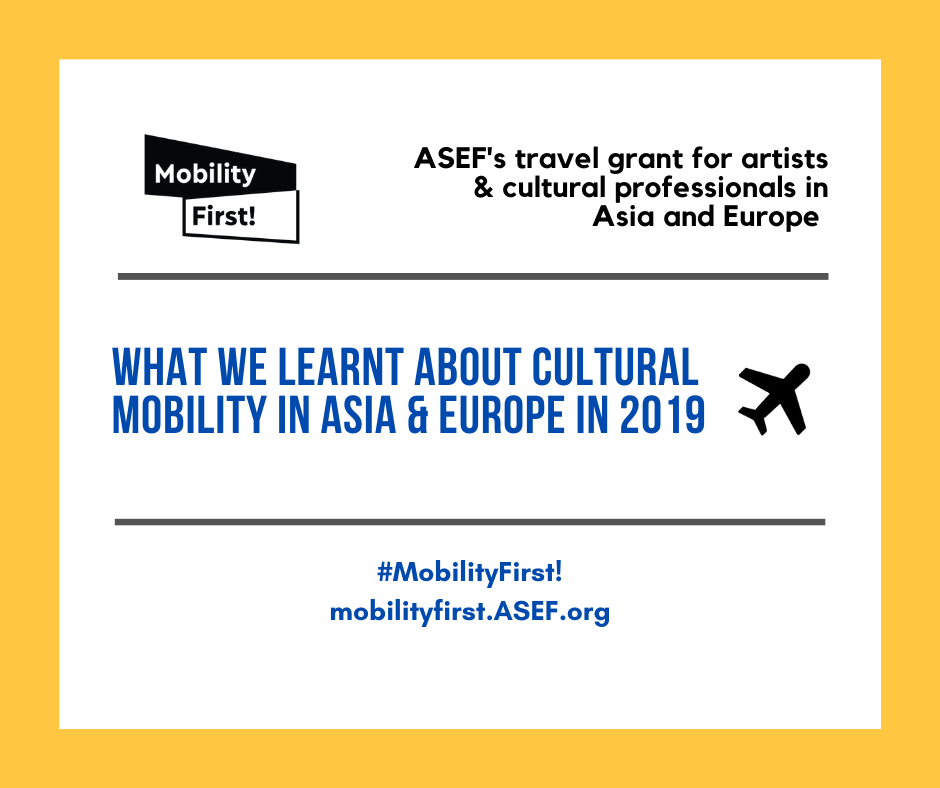
culture360.ASEF.org features Mobility First!, ASEF’s travel grant for artists and cultural professionals. With most of us having to physically stay home to slow the spread of Covid-19, our work as mobility funders, artists and cultural professionals have also evolved. As we adjust to the new normal, we review some key trends to cultural mobility in Asia and Europe from 2019.
Background of Mobility First
Mobility First! is the Asia-Europe Foundation (ASEF)’s travel grant for artists and cultural professionals to support their international travel costs when participating in activities that are integral to their professional development; and, that would initiate a multiplier effect to others and benefit the society.
To date, Mobility First! has supported 312 cultural professionals to facilitate cultural exchange between 48 Asia-Europe Meeting (ASEM) countries.
In 2019, Mobility First! enabled 104 cultural professionals from 25 ASEM countries to participate in 57 arts events across 29 countries in Asia and Europe.
The benefits of cross border mobility experiences have been reiterated by our grantees: the exposure to intercultural exchanges and cultural diversity pushes them out of their comfort zones, artistically and personally; capacity building (which includes building networks for one’s career, sector or organisation), or even outreaching to new local audiences in other geographical areas.
Check out some key trends to cultural mobility in Asia and Europe from our 2019 in review.
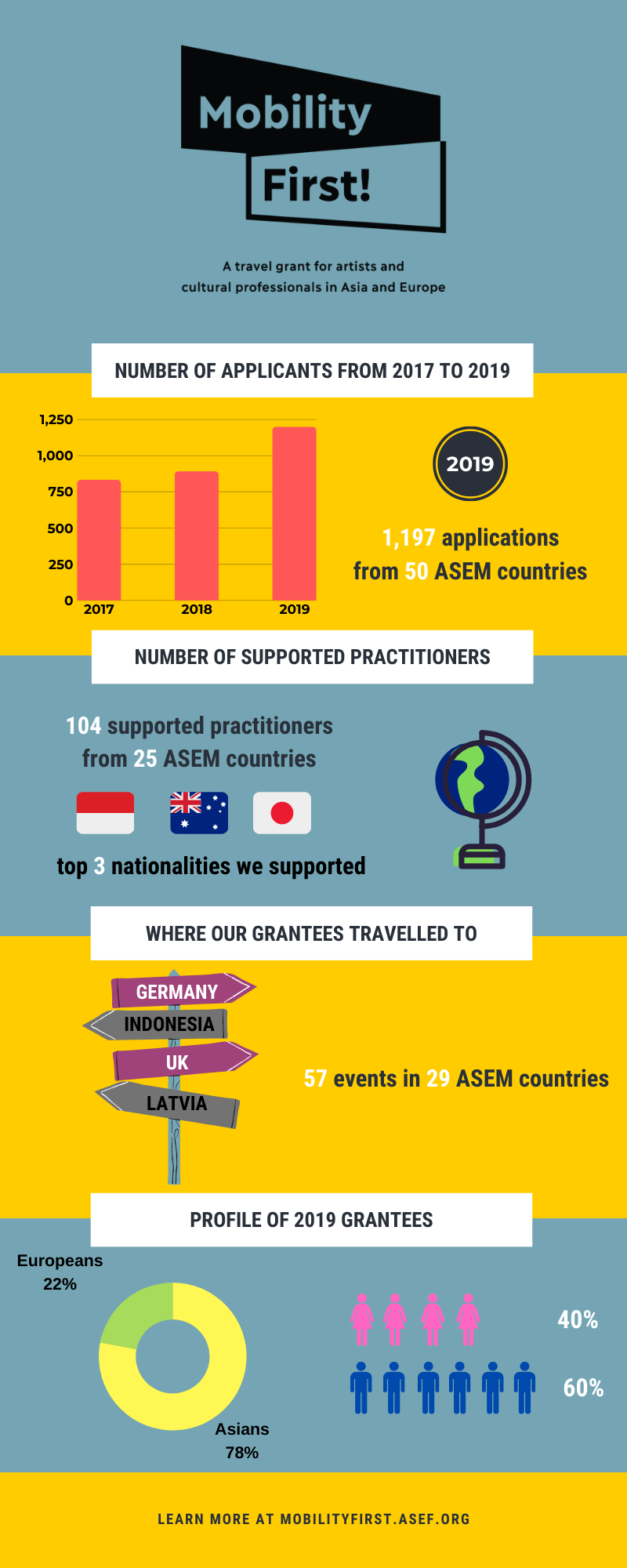
Overview of mobility in Asia and Europe
1) Geographic origins
In summary, for outgoing mobility applications, Mobility First! received a total of 606 applications made directly by individual artists/cultural professionals. On the other hand, 155 organisations applied for a total of 510 people to participate in their events.
Applications received were from all European ASEM partner countries and 20 out of 21 Asian partner countries. No applications were received from Brunei Darussalam.

The number of applications received has steadily increased over the years, indicating that the desire for mobility is still very strong amongst artists and cultural professionals based in Asia and Europe.
Majority of the applicants applied within a framed type of opportunity, which means that they have been invited to or selected for participation in a cultural event abroad. Whereas, there were only a handful of applicants who were applying to travel for self-initiated projects. Whilst offer led opportunities are the main reason for mobility, practitioners are encouraged to develop their own research and exploratory ambitions.
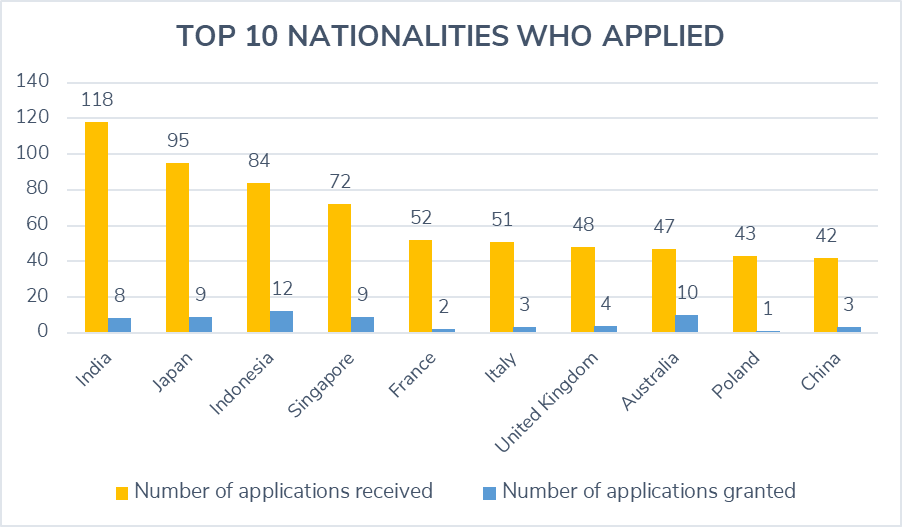
The top 10 nationalities list is almost identical to that of 2017 and 2018, with the addition of Australia and Poland in 2019.
India, Japan, Indonesia, Singapore, Italy, United Kingdom and China are among the top 10 nationalities of applicants since Mobility First! was launched in 2017.
Throughout the past three years, Mobility First! has consistently received the highest number of applications from India and from Asian nationalities in general.
Aside from the plausible wider mobility funding gaps within Asia, one reason for the higher Asian applications could be due to arts practitioners in Asia feeling the need to travel to experience the artistic, economic and political climate of other countries.
As expressed by several Mobility First! grantees, in the Asian context, arts and culture are typically either secondary to economic developments or are predominantly viewed as a luxury, rather than an essential part of society. The disparity in perceptions of the arts and culture in Asia in comparison to Europe has hence inspired Asian arts practitioners to cross borders temporarily.
2) Mobility routes

From 2017-2018, Europe to Asia mobility routes comprised majority of the applications received. In 2019 however, the Asia to Europe mobility route was the most popular, comprising 43% of all applications, followed by Europe to Asia (37%) and intra-Asia (19%).
The increase in Asia to Europe mobility could presumably be due to the strong and vibrant arts and cultural sector in Europe and its capacity to host international events.This trend likely coincides with the 2019 being the year of major arts international events as well, with events such as the Venice Biennale, OSTRALE Biennale in Dresden and Prague Quadrennial.
In addition, there were a significant number of cultural cooperation agreements and programmes that were launched in 2019, facilitating the movement of artists between Asia and Europe. For instance, the Latvian-Indian Cultural Cooperation programme which was signed in Riga in August 2019, covering cooperation between the two countries in artforms such as music and dance, cultural heritage, film, museums and more. Other agreements include the Lithuanian-India cultural cooperation agreement or the renewal of the cultural cooperation agreement between France and Singapore.
|
Where in Europe did Asians want to go? |
Number of applications received |
|
United Kingdom |
76 |
|
Italy |
58 |
|
Germany |
53 |
|
France |
47 |
|
Spain |
27 |
|
Poland |
26 |
|
Netherlands |
21 |
|
Lithuania |
20 |
|
Switzerland |
18 |
|
Czech Republic |
17 |
Despite the growing arts and cultural sector in Europe, data trends show that cultural professionals are more focused on the opportunities to travel, make contacts, build partnerships, conduct research, etc., in Western Europe.
For the past 3 years, the United Kingdom has consistently been the most popular destination country amongst Asian applicants. Notably, the performing arts, visual arts and film/new media were the most popular fields of art that applicants who wanted to travel to the United Kingdom worked in. This is to a certain extent linked to the widespread support for these disciplines in the United Kingdom.
|
Where in Asia did Europeans want to go? |
Number of applications received |
|
Japan |
140 |
|
China |
54 |
|
Korea |
46 |
|
Indonesia |
34 |
|
India |
31 |
|
Singapore |
25 |
|
Thailand |
25 |
|
Australia |
22 |
|
Russian Federation |
17 |
|
Viet Nam |
12 |
East Asian countries (China, Japan and Korea) remain the most popular destination countries for European applicants; this trend has been ongoing since 2017.
|
Where in Asia did Asians want to go? |
Number of applications received |
|
Malaysia |
29 |
|
Indonesia |
28 |
|
Australia |
27 |
|
Japan |
23 |
|
Thailand |
17 |
|
Singapore |
15 |
|
China |
15 |
|
Russian Federation |
12 |
|
India |
11 |
|
Viet Nam |
10 |
In 2019, Japan was the most popular destination for Europeans travelling to Asia and was also ranked 4th amongst Asians travelling within Asia.
This could be due to the numerous cultural programmes that were being organised in the lead up to the Tokyo Olympic Games 2020, indicating more room for support in the arts and culture, where artists are provided with more opportunities to either participate, perform or learn.
Being the host of the Olympic Games has undeniably given Japan global attention and more people are noticing Japan now.
|
|
% of applicants |
|
|
|
Asian |
European |
|
Artist |
45% |
27% |
|
Not an artist but works in the cultural sector |
17% |
11% |
In 2019, 72% of applications were from artists, who are also the main beneficiaries of the Mobility First! grant.
Interestingly, both Asian and European artists and those working in the cultural sector have indicated interests in attending similar types of activities. Among artists, the most popular activities were festivals, artists’ residencies and workshops.
Whilst for those working in the arts and culture field but are not directly involved in the production of artworks (e.g. curators, arts managers, policy makers, researchers etc.), participation in festivals, conferences and workshops were the most popular amongst them.
As mentioned by the grantees, the highlights from participation in festivals, artists’ residencies and workshops were the experiences of peer to peer exchanges, which were very much based on the compatibility of the people involved, who were genuine and willing to share their knowledge.
Irrespective of disciplines, data shows that many applicants engage in multiple formats of activities. For instance their proposed activities would include a combination of training + artist residency or a practice-led research trip + partnership meeting.
The combination of formats can be explained by the various objectives a travel opportunity can have, where mobility is a means to an end of ensuring that there is value add to the cultural professionals’ artistic and cultural practice.
Gender & age of applicants
As per the past two years, gender equality and youth inclusion have been priorities for Mobility First!
In terms of gender, applications received had an almost equal representation from males and females. Whilst in terms of age, Mobility First! received an almost equal representation from those below and above 35 years of age and supported applications in the same proportion
|
Age |
% of applicants |
|
|
35 years old and above |
48% |
50% |
|
Under 35 years old |
52% |
50% |
5) Special open calls
In line with Mobility First!’s contribution to the pursuit of the Sustainable Development Goals (SDG) – in particular to SDG #4: Ensure inclusive and equitable quality education, and promote lifelong learning for all) and SDG #5: Achieve gender equality and empower all women, ASEF collaborated with the Prince Claus Fund for Culture and Development to launch a special joint call supporting the mobility of young artists, women and minority groups.
The special joint call supported 25 cultural professionals to travel to 14 ASEM countries and participate in 20 events.
- 15 of 25 supported practitioners were female (60%)
- 19 of 25 were young professionals, under the age of 35 (76%)
2 additional joint calls were established with Cambodian Living Arts (CLA) – 1) For artists working in precarious conditions and are affected by present day conflict, 2) Promoting South-South mobility.
Both calls were launched in response to UNESCO’s reiteration of the importance of freedom of movement and artistic freedom and inadequate access to funding opportunities for artists and cultural professionals in the Global South (as detailed in the Re-shaping Cultural Policies, UNESCO 2018 Global Report)
Selected applicants from our joint calls were inspirational in that their projects were centred around bringing art to new local audiences. This likely indicates that applicants mostly chose their destination city based on the relevance and applicability of their project for a specific context (be it a huge city or a rural area).
Mobility First! - ASEF Cultural Mobility Initiative is the Asia-Europe Foundation (ASEF)'s travel grant that supports the international travel for artists and cultural professionals in Asia-Europe and Intra-Asia contexts. It was first launched in 2017 in celebration of our 20th anniversary and builds on our continued support to cultural mobility. 2020 marks the 4th year of Mobility First!
Similar content
By Fatima Avila and Kerrine Goh
30 Aug 2019
By Fatima Avila
27 Mar 2018
deadline
15 Jun 2019
deadline
30 Jun 2018
05 Dec 2018
deadline
28 Feb 2020


